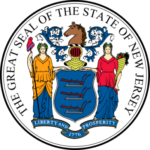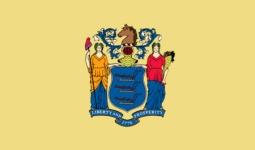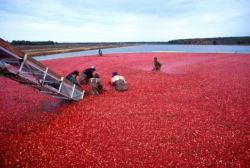New Jersey
New Jersey is a state in the Northeastern and Middle Atlantic regions of the United States. It is bordered on the north and east by New York State, on the southeast and south by the Atlantic Ocean, on the west by Pennsylvania, and on the southwest by Delaware.
- ABBREVIATION: NJ
- NICKNAME: The Garden State
- POPULATION: 8,899,339 (2013 est.)
- CAPITAL: Trenton
- STATE BIRD: Eastern Goldfinch
- STATE FLOWER: Purple violet
- AREA: 8,729 sq. mi.
- TIME ZONE: Eastern
- ENTERED UNION: Dec. 18, 1887
- ALTITUDE: High, 1,803 ft. High Point
- CLIMATE: Warm summers, cool winters along seacoast; considerable snow in highlands. Ample rainfall.


Long before it became a state, New Jersey served as a well-trodden corridor for the march of history. For centuries Iroquois and Delaware hunting and war parties roamed its inner lowlands; in the early 1770’s, Paul Revere galloped across the same lowlands to Philadelphia with the news of the Boston Tea Party. Today, New Jersey is primary a transportation center, Newark Airport, a pioneer commercial airport which opened in 1928 as the first major airport in the United States, is still one of the nation’s busiest air terminals.
After the American Revolution, the water power of the Passaic River was harnessed near Paterson, which became the country’s first planned industrial city. Once the silk capital of the nation and still a great textile center, Paterson is today renowned-like most New Jersey cities-for its diversity of products (metal and rubber goods, furniture, plastics). With its industry and small stores, Paterson has always been a magnet for immigrants. It was once one of the richest industrial regions in the world. In the 19th century, New Jersey cities led the nation into the Industrial Revolution.

In the 21st Century New Jersey has been deeply affected by terrorism and political controversy. The destruction of the twin towers could be seen from New Jersey, and Todd Beamer, of New Jersey, is thought to have played a role in bringing down Flight 93 short of the terrorists’ intended target. In 2001, a Trenton, New Jersey postmark was used to send anthrax bacteria, via the mail, to several news media offices and two US Senators; this action resulted in the deaths five people and injured dozens of others. In 2014, New Jersey Governor Chris Christie continues to make controversial headlines and stir political turmoil.
FUN FACTS:
- Beneath the Pine Barrens lie aquifers that hold 17 trillion gallons of fresh water.
- Early settlers mined the bogs of the Pine Barrens for iron to make nails, kettles, and cannonballs.
- Famed inventor Thomas Edison filed for more than 400 patents from his laboratory in Menlo Park. During the seven years he worked there, his achievements included perfecting the light bulb and the telephone, inventing the phonograph (record player), and inventing the multiplex telegraph.
- Cape May became the nation’s first seaside resort in 1761. It was named by the Dutch sea captain Cornelius Jacobsen Mey (in English often rendered Cornelius Jacobsen ‘May’), who explored the region in 1620. In recognition of its well-preserved Victorian houses it was named a National Historic Landmark City in 1976.
- The first dinosaur skeleton found in North America was excavated at Haddonfield in 1858. It was named Hadrosaurus on honor of its discovery site.
- New Jersey is home to the first Indian reservation.
